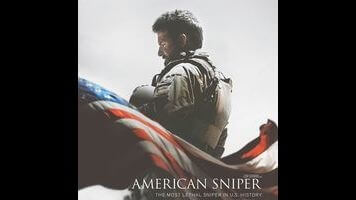Clint Eastwood’s American Sniper is a war movie that’s tensest on the home front

Clint Eastwood directs in the old-fashioned, literal sense; he puts the camera where it belongs and gives the actors enough room to work, but not so much that they start vamping and lose track of the scene. His style is clean and shadowy, and it can be delicate as a whisper when the moment calls for it. He’s a classicist, but not a perfectionist. His work, and the later films, especially, can be rough around the edges, but one would be hard pressed to find a purer example of American movie directing in this day and age.
If you’re wondering why any of this stuff matters, look no further than the climax of American Sniper—an extraction set against the backdrop of a sandstorm with 6-inch visibility. The whole screen goes brownish red; the roar of the wind covers the soundtrack. And yet, though you can only make out the silhouettes of the characters, the whole scene is legible: who’s going where, where the threat is, how far away. That’s what it means to direct a movie.
American Sniper is imperfect and at times a little corny, but also ambivalent and complicated in ways that are uniquely Eastwoodian. Like so many of Eastwood’s movies since the 1990s—Unforgiven, Million Dollar Baby, and J. Edgar among them—it’s about a man doing something morally wrong in order to ensure a better world. And, like those earlier films, it doesn’t really question its protagonist’s values or justifications, instead focusing on the toll—as much spiritual as psychological—that his decisions take on him.
It opens with Chris Kyle (Bradley Cooper), the late Navy SEAL whose four tours in Iraq gave him a reputation as the deadliest sniper in American military history. He’s lying flat on a rooftop, with a convoy rumbling through the street below. He sights a woman and child moving suspiciously in the direction of a tank. They could be carrying an explosive, or they could be confused; regardless, the decision to pull the trigger rests entirely on him. It has a heavy, crushing weight, and Eastwood and his longtime cinematographer, Tom Stern, stage the scene for maximum queasy tension.
This is the crux of American Sniper—the point from which it proceeds, first by flashing back to explain how it is that a basically decent person comes to find himself aiming a high-powered rifle at a child, and then by examining how such a person could ever re-adjust to a life away from war. Cooper, for his part, has gone more or less full method for the role. Bulked up and bearded past the point of recognizability, he speaks in a shy, mumbling Texas drawl, the polar opposite of his usual hyper-verbal screen persona. And because of Eastwood’s preference for doing minimal numbers of takes—sometimes just one, if everybody hits their marks—this performance never comes across as overly acted or crafty. Instead, Cooper’s Kyle comes across as though he’s simply being recorded, as though he continues to exist even when the camera is off.
This matters a lot in the scenes set between tours, which depict Kyle’s life in suburban Texas with his wife Taya (Sienna Miller) and their kids. American Sniper has more than its share of enemy-in-the-crosshairs set pieces, but these back-home scenes are the real backbone of the movie, especially the sequence in which Kyle is recognized by a veteran (Jonathan Groff) in an auto body shop, but is unable to maintain eye contact with him. The scene is a miniature master class in subdued tension and subtly discomfited acting, and, along with a scene in which Taya talks Kyle into measuring his blood pressure during a doctor’s office visit, amounts to one of the most effective and understated depictions of post-traumatic stress in the history of the American war movie.
American Sniper never undermines the sincerity of Kyle’s worldview. This isn’t a man haunted by guilt or violence; as far as Kyle is concerned, he did necessary but troubling work in a necessary but troubling war. What the movie does, instead, is complicate that sincerity; much of the direction and script—by Jason Hall, who wrote David Mackenzie’s very underrated and ambivalent Spread—hints at the idea that Kyle isn’t really cognizant of the effect killing so many people has had on him. Instead of giving him an ah-ha moment of self-awareness, the movie preserves this essential part of his character, and then plays it against him, perhaps too subtly for most tastes.
American Sniper’s Iraq sections add up to a continuous, taut war-movie narrative, with Kyle matched against an invented nemesis named Mustafa (Sammy Sheik), based on the (possibly fictive) insurgent sniper Juba—a morale-building propaganda tool, much like Kyle himself. And yet, this war movie is continually interrupted by returns home, which find Kyle and assorted other veterans failing to adjust to the rhythms of a life outside of war. (One of Eastwood’s clearest expressions of this idea involves cutting a freeway argument between the Kyles like a chase scene, as though every passing car were a potential threat.) Kyle is rarely without a battered baseball cap; in Iraq, he wears it backwards, like a good-luck charm, but in Texas he pushes its brim all the way down over his eyes, even when indoors, as though he were protecting himself from a glare only he can see.